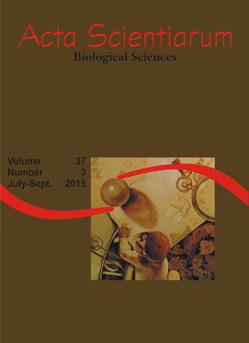<b>Morphoanatomy of <i>Serjania communis</i> Cambess. seedling (Sapindaceae)
Resumo
Serjania communis Cambess. (Sapindaceae) is a plant with climbing habit and occurs relatively often in Paraná State, Brazil. The fruits were collected at the 'Parque dos Pioneiros' a remnant of subtropical forest in Maringá, Paraná State, Brazil. The seedlings obtained in the greenhouse were described according to traditional techniques in plant morphology. Seedlings were embedded in historesin and sectioned in rotation microtome. The fruit is the samaroid type, the seeds have about 3 mm in length and brown color. Seedlings are epigeal phanerocotylar. The seedlings have a hairy hypocotyl, foliaceous cotyledons, reduced epicotyl, and two opposite eophylls. The root is diarch, the hypocotyl shows root-stem transition structure, stem epicotyl, and dorsiventral and hypostomatous cotyledons and eophylls. 'Tirodendros' with 45 days of age do not develop cambial variant.
Downloads
DECLARAÇÃO DE ORIGINALIDADE E DIREITOS AUTORAIS
Declaro que o presente artigo é original, não tendo sido submetido à publicação em qualquer outro periódico nacional ou internacional, quer seja em parte ou em sua totalidade.
Os direitos autorais pertencem exclusivamente aos autores. Os direitos de licenciamento utilizados pelo periódico é a licença Creative Commons Attribution 4.0 (CC BY 4.0): são permitidos o compartilhamento (cópia e distribuição do material em qualqer meio ou formato) e adaptação (remix, transformação e criação de material a partir do conteúdo assim licenciado para quaisquer fins, inclusive comerciais.
Recomenda-se a leitura desse link para maiores informações sobre o tema: fornecimento de créditos e referências de forma correta, entre outros detalhes cruciais para uso adequado do material licenciado.












1.png)




3.png)













